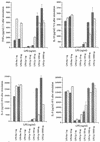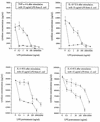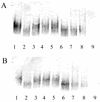Low endotoxic potential of Legionella pneumophila lipopolysaccharide due to failure of interaction with the monocyte lipopolysaccharide receptor CD14
- PMID: 9712761
- PMCID: PMC108499
- DOI: 10.1128/IAI.66.9.4151-4157.1998
Low endotoxic potential of Legionella pneumophila lipopolysaccharide due to failure of interaction with the monocyte lipopolysaccharide receptor CD14
Abstract
Legionella pneumophila, a gram-negative bacterium causing Legionnaires' disease and Pontiac fever, was shown to be highly reactive in in vitro gelation of Limulus lysate but not able to induce fever and the local Shwartzman reaction in rabbits and mice. We analyzed the capacity of purified L. pneumophila lipopolysaccharide (LPS-Lp) to induce activation of the human monocytic cell line Mono Mac 6, as revealed by secretion of proinflammatory cytokines and desensitization to subsequent LPS stimulation. We showed that despite normal reactivity of LPS-Lp in the Limulus amoebocyte lysate assay, induction of cytokine secretion in Mono Mac 6 cells and desensitization to an endotoxin challenge required LPS-Lp concentrations 1,000 times higher than for LPS of Salmonella enterica serovar Minnesota. Therefore, we examined the interaction of LPS-Lp with the LPS receptor CD14. We demonstrated that LPS-Lp did not bind to membrane-bound CD14 expressed on transfected CHO cells, nor did it react with soluble CD14. Our results suggest that the low endotoxic potential of LPS-Lp is due to a failure of interaction with the LPS receptor CD14.
Figures






Similar articles
-
Human monocytes lacking the membrane-bound form of the bacterial lipopolysaccharide (LPS) receptor CD14 can mount an LPS-induced oxidative burst response mediated by a soluble form of CD14.Res Immunol. 1995 Jul-Aug;146(6):339-50. doi: 10.1016/0923-2494(96)81038-8. Res Immunol. 1995. PMID: 8719658
-
Legionella pneumophila LPS to evaluate urinary antigen tests.Diagn Microbiol Infect Dis. 2017 Oct;89(2):89-91. doi: 10.1016/j.diagmicrobio.2017.06.013. Epub 2017 Jun 23. Diagn Microbiol Infect Dis. 2017. PMID: 28780244
-
Bordetella Pertussis Toxin does not induce the release of pro-inflammatory cytokines in human whole blood.Med Microbiol Immunol. 2012 Aug;201(3):327-35. doi: 10.1007/s00430-012-0238-1. Epub 2012 Apr 15. Med Microbiol Immunol. 2012. PMID: 22527330
-
CD14 and other recognition molecules for lipopolysaccharide: a review.Immunopharmacology. 1995 Apr;29(3):187-205. doi: 10.1016/0162-3109(95)00003-c. Immunopharmacology. 1995. PMID: 7542643 Review.
-
Innate immunity against Legionella pneumophila during pulmonary infections in mice.Arch Pharm Res. 2017 Feb;40(2):131-145. doi: 10.1007/s12272-016-0859-9. Epub 2017 Jan 6. Arch Pharm Res. 2017. PMID: 28063015 Review.
Cited by
-
Infectious (Non)tolerance--frustrated commensalism gone awry?Cold Spring Harb Perspect Biol. 2012 May 1;4(5):a007328. doi: 10.1101/cshperspect.a007328. Cold Spring Harb Perspect Biol. 2012. PMID: 22456498 Free PMC article. Review.
-
Genome sequence and phenotypic analysis of a first German Francisella sp. isolate (W12-1067) not belonging to the species Francisella tularensis.BMC Microbiol. 2014 Jun 25;14:169. doi: 10.1186/1471-2180-14-169. BMC Microbiol. 2014. PMID: 24961323 Free PMC article.
-
Protein sociology of ProA, Mip and other secreted virulence factors at the Legionella pneumophila surface.Front Cell Infect Microbiol. 2023 Mar 2;13:1140688. doi: 10.3389/fcimb.2023.1140688. eCollection 2023. Front Cell Infect Microbiol. 2023. PMID: 36936764 Free PMC article. Review.
-
Expression of sialic acids and other nonulosonic acids in Leptospira.BMC Microbiol. 2012 Aug 1;12:161. doi: 10.1186/1471-2180-12-161. BMC Microbiol. 2012. PMID: 22853805 Free PMC article.
-
The Role of Lipids in Legionella-Host Interaction.Int J Mol Sci. 2021 Feb 2;22(3):1487. doi: 10.3390/ijms22031487. Int J Mol Sci. 2021. PMID: 33540788 Free PMC article. Review.
References
-
- Blondiau C, Lagadec P, Lejeune P, Onier N, Cavaillon J M, Jeannin J F. Correlation between the capacity to activate macrophages in vitro and the antitumor activity in vivo of lipopolysaccharides from different bacterial species. Immunobiology. 1994;190:243–254. - PubMed
-
- Fumarola D. Attempts to biological demonstration of endotoxin potency in Legionella pneumophila. Ann Sclavo. 1979;21:258–263. - PubMed
MeSH terms
Substances
LinkOut - more resources
Full Text Sources
Molecular Biology Databases
Research Materials

